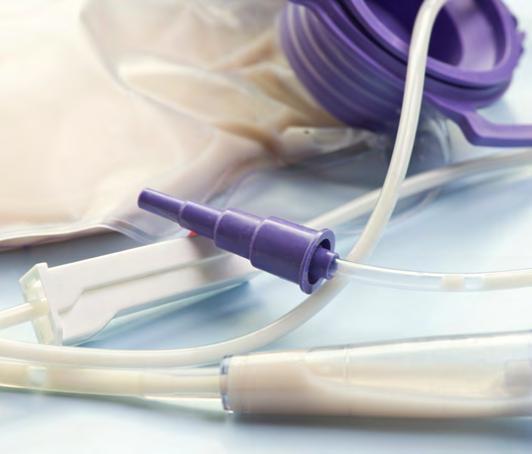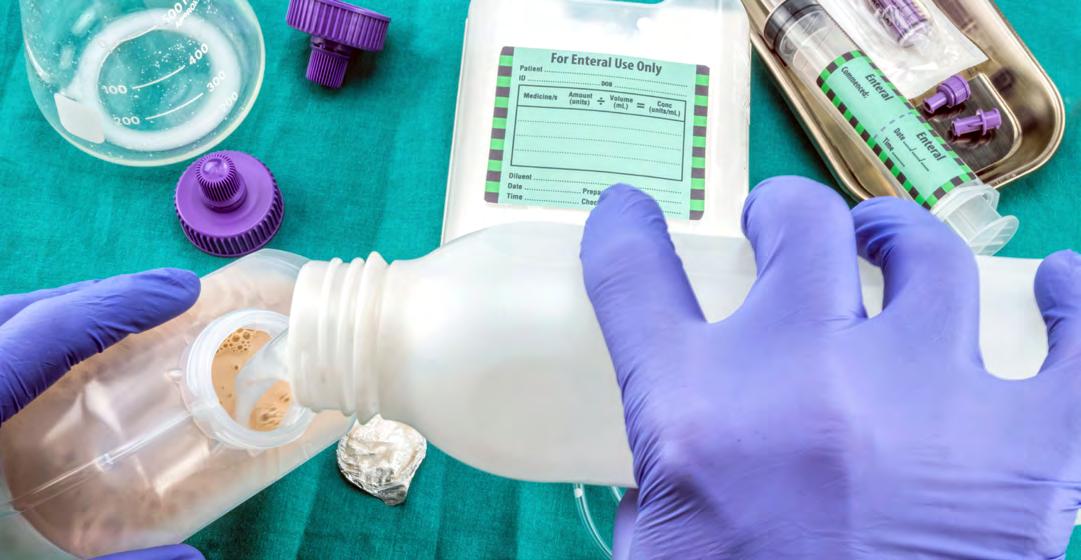

ENTERAL NUTRITION GUIDE
ENTERAL NUTRITION OVERVIEW
Enteral nutrition delivers nutrients and hydration when a person cannot consume enough to sustain themselves. It is provided when there is an illness, swallowing impairment, digestive disease, or surgical procedure that partially impairs the digestive tract while still being able to absorb and digest nutrients. If absorption and digestion are completely impaired, parenteral nutrition is provided.
Enteral nutrition provides liquid nutrients in two forms: orally as a drink or through a tube into the stomach or small bowel, which is often called tube feeding. Depending on the impairment causing the need for tube feeding, the formula can be administered by syringe, gravity bag, or enteral feeding pump. The use of a pump generally requires medical necessity documentation by the physician.
Enteral nutrition is available in many formulations that vary in total calories, protein, carbohydrates, fats, vitamins, minerals, fiber, and water content. They are available in pediatric formulations for ages 1-13 and adult formulations for ages 14 and up. Infant formula is given to babies 0-12 months of age and sometimes up to age 2. Enteral nutrition can be ordered by total calories of a specified formula or by a milliliter volume per hour.
ENTERAL MARKET
The global enteral nutrition market is forecasted for a CAGR of 5.9% from 2021 to 2028 due to the growing prevalence of chronic diseases. Many cancers, stroke, multiple sclerosis, chronic liver disease, chronic obstructive pulmonary disease (COPD), and diabetes are the most common to impair the gastrointestinal tract. These diseases are projected to drive the demand for tube-fed enteral products which support patients with oral intake issues. In addition, the rise in preterm births is one of the significant factors boosting the demand for enteral formulas to meet the nutritional requirements in pediatrics.
In 2020, based on end user, the homecare segment accounted for the highest enteral nutrition revenue share at 56.1% of the market and is projected to have the fastest CAGR over the forecast period. The increasing number of patients that receive home enteral feeding due to growing awareness about complete and balanced nutrition is one of the key factors contributing to the growth of this segment.1

The rapidly aging population will also play a large role in the growth of home enteral feeding. According to the Population Reference Bureau’s Population Bulletin, Aging in the United States, Americans aged 65 and older are projected to nearly double from 52 million in 2018 to 95 million by 2060.
If your DME business focuses on any of these chronic diseases, enteral feeding should be a secondary therapy you provide to offer comprehensive care to those patients.
REIMBURSEMENT
Nutrition via a feeding tube can be needed for a short time while recovering from a temporary impairment or for a lifetime due to a permanent impairment. Shortterm tube feeding can be difficult to get reimbursed by commercial payers and is not covered by Medicare.
While CMS no longer includes a qualifier of 90 days or greater, the physician must document an indefinite length of need.
Medicare covers enteral nutrition under the Medicare Part B prosthetic device benefit for beneficiaries at home when it is administered via a feeding tube. Orally administered enteral supplements are not covered under Medicare Part B but may be covered under some state Medicaid programs, particularly waiver programs and some commercial insurances. However, because some Medicaid and commercial insurances use the Medicare coverage policy to set their own coverage policies, this can limit coverage of enteral products that are not required because of permanent impairment or when administered orally.
Some commercial insurances cover the pump and supplies that are required to deliver the tube feeding but not the enteral formula itself. Medicaid and WIC provide coverage when there is a documented medical necessity.
Under CMS, enteral nutrition is billed in 100 calorie units. Thus, a 250ml container of 1.5 calories per ml formula = 375 calories or 3.75 billing units per container. If a patient’s prescribed total daily calories is 1800 kcal, they are receiving 18 billing units of formula per day.
In order to justify payment for enteral DMEPOS items under CMS, suppliers must meet the following requirements:
» Standard Written Order (SWO)
» Medical Record Documentation that meets the coverage criteria within the medical policies
» Correct Coding
» Proof of Delivery

A Standard Written Order (SWO) must be communicated to the supplier before a claim is submitted for payment. If the supplier bills for an item addressed in this policy without first receiving a completed SWO, the claim shall be denied as not reasonable and necessary.
An item/service is correctly coded when it meets all the coding guidelines listed in CMS HCPCS guidelines, LCDs, LCD-related Policy Articles, or DME MAC articles. Claims that do not meet coding and coverage guidelines shall be denied as not reasonable and necessary.
There are certain products that must be verified by the HCPCS coding contractor (PDAC). These codes are B4149, B4153, B4154, B4155, B4157, B4161, and B4162.
The policy article goes into detail for the HCPCS code description and codes requiring verification review. Information can also be found at www.dmepdac. com using the product classification list (PCL).
Proof of delivery (POD) is a Supplier Standard, and DMEPOS suppliers are required to maintain POD documentation in their files. POD documentation must be made available to the Medicare contractor upon request. All services that do not have appropriate POD from the supplier shall be denied as not reasonable and necessary.
REFILL REQUIREMENTS
For DMEPOS items and supplies provided on a recurring basis, billing must be based on prospective use, not retrospective. For DMEPOS products that are supplied as refills to the original order, suppliers must contact the beneficiary prior to dispensing the refill and not automatically ship on a pre-determined basis, even if authorized by the beneficiary. This shall be done to ensure that the refilled item remains reasonable and necessary, existing supplies are approaching exhaustion, and to confirm any changes or modifications to the order. Contact with the beneficiary or designee regarding refills must take place no sooner than 30 calendar days prior to running out of supplies. For delivery of refills, the supplier must deliver the DMEPOS product no sooner than 10 calendar days prior to the end of usage for the current product. This is regardless of which delivery method is utilized.
For all DMEPOS items that are provided on a recurring basis, suppliers are required to have contact with the beneficiary or caregiver/designee prior to dispensing a new supply of items. Suppliers must not deliver refills without a refill request from a beneficiary. Items delivered without a valid, documented refill request will be denied as not reasonable and necessary.
Suppliers must not dispense a quantity of supplies exceeding a beneficiary’s expected utilization. Suppliers must stay attuned to changed or atypical

utilization patterns on the part of their clients. Suppliers must verify with the treating practitioner that any changed or atypical utilization is warranted.
Regardless of utilization, a supplier must not dispense more than a one-month quantity at a time.
Supply allowance HCPCS codes (B4034, B4035, and B4036) are daily allowances which are considered all-inclusive, and therefore, refill requirements are not applicable to these HCPCS codes. Refer to the Coding Guidelines section in the LCD-related Policy Article for further clarification.
CONTINUED MEDICAL NEED
Another key piece of billing and reimbursement is proving continued medical need.
Continued medical need comes from the treating practitioner. Because enteral nutrition is a supply item, this requirement can be met with a valid SWO annually.
More information can be found regarding continued medical need and continued use in the Standard Documentation Requirement Policy (SDR).
CMS ENTERAL RESOURCES
Enteral Nutrition Calculator
Fee Schedule Look-up Tool
Noridian Enteral Resources
CGS Enteral Checklist
Clinician Enteral Checklist
Dear Physician Letter – CERT Enteral Nutrition
ENTERAL FORMULARY
Reimbursement margins for enteral formulas and the administration supplies have historically been low from Medicare and many other payers. Converting to and following a primary brand formulary is one way to increase your overall enteral margin.
A formulary is putting the majority of your patient volume for that therapy category on a designated brand. Many manufacturers offer better pricing with a committed volume. On average, manufacturers can afford to lower pricing for a pre-set minimum annual spend and compliance usage of 70%+ of your patients on their brand. This is similar to a drug formulary followed by hospitals, so physicians are not unfamiliar with the concept. When required for clinical reasons or for strong preference, patients can remain on another brand.

ENTERAL GLOSSARY
EN – Enteral Nutrition
PEN – Parenteral Nutrition
ONS – Oral Nutrition Supplements
UOS – Units of Service
LON – Length of Need
DIF – DME Information Form
SWO – Standard Written Order
MUE Tool– Medically Unlikely Edit
PDAC – Pricing, Data Analysis, and Coding
CERT – Comprehensive Error Rate Testing
ADR – Additional Documentation Request
EPI – Exocrine Pancreatic Insufficiency
NG Tube – Nasogastric Tube
G Tube – Gastrostomy Tube
J Tube – Jejunostomy Tube
1 Enteral Feeding Formulas Market Size, Share & Trends Analysis Report By Product, By Flow Type, By Stage (Adult, Pediatric), By Indication, By End-user, By Region, And Segment Forecasts, 2021 - 2028
• Published Date: Feb. 2021
• Base Year for Estimate: 2020
• Report ID: GVR-1-68038-060-6
https://www.grandviewresearch.com/industry-analysis/enteral-feeding-formulas-market
